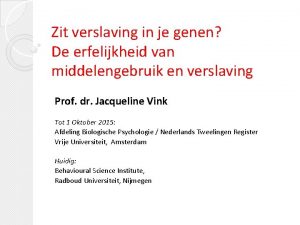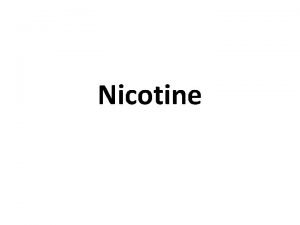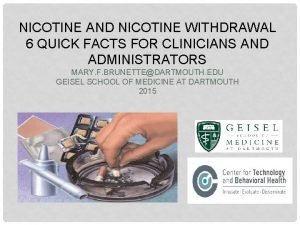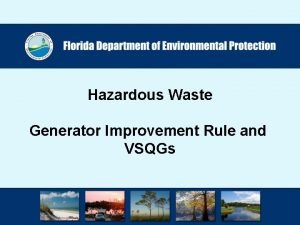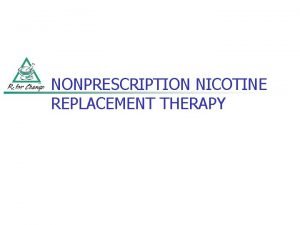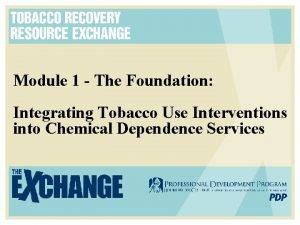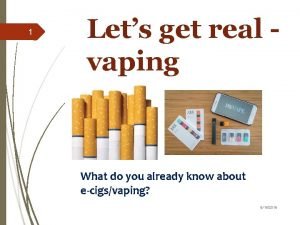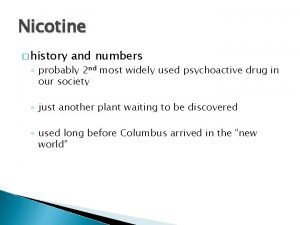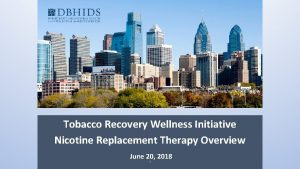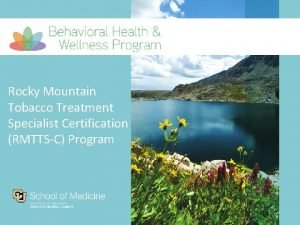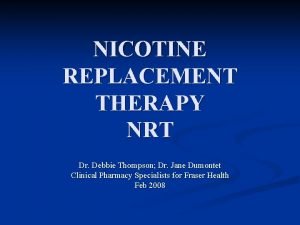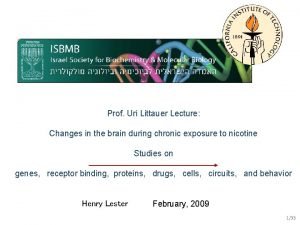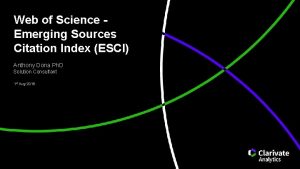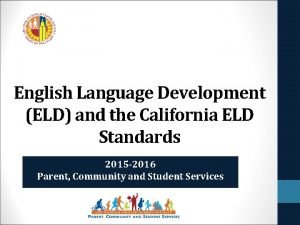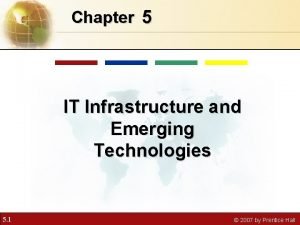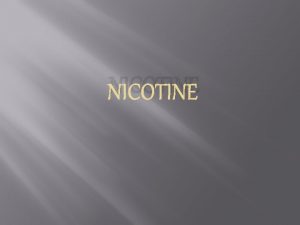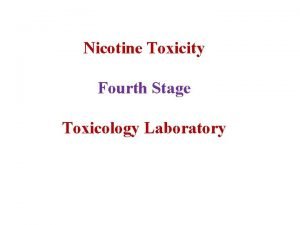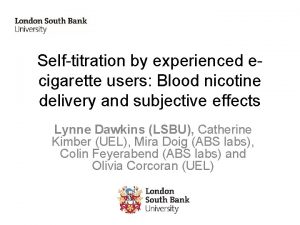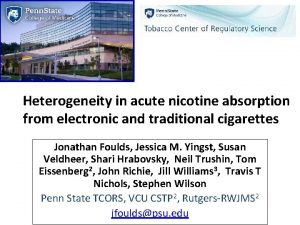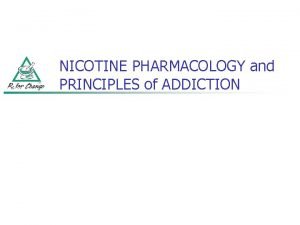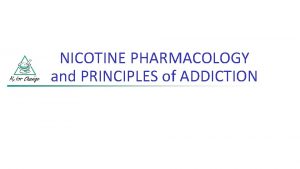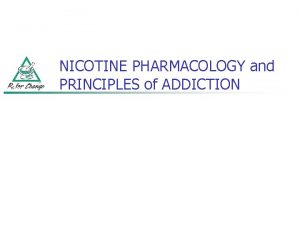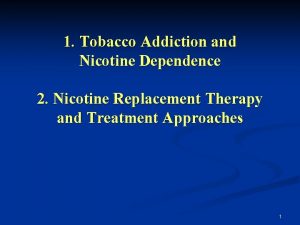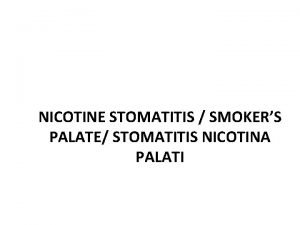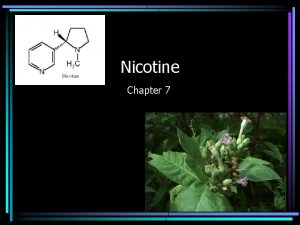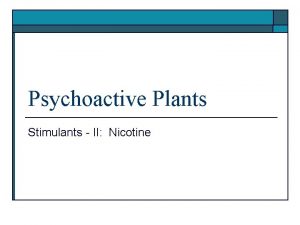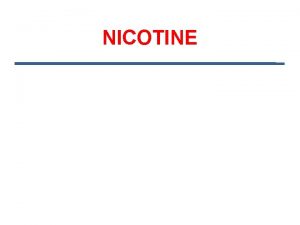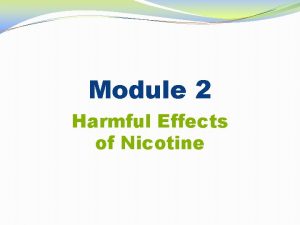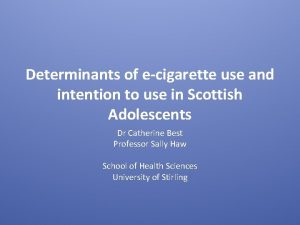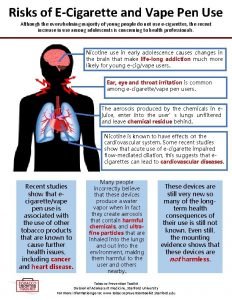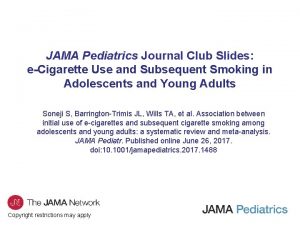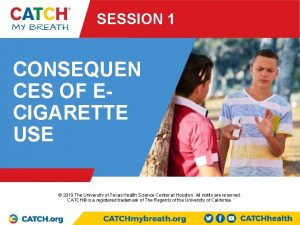The Emerging Science of ECigarette Use and Nicotine


























- Slides: 26

The Emerging Science of E-Cigarette Use and Nicotine Addiction 2016 -2017 TCN Podcast Series Dr. Jay C. Butler, Alaska Department of Health and Social Services and ASTHO President Dr. Brian King, CDC Office on Smoking and Health Matthew Green, Washington Department of Health

2017 President’s Challenge Jay C. Butler, MD, CPE Chief Medical Officer, Alaska Department of Health and Social Services Director, Division of Public Health

A Web of Cause and Effect LIMITED ACCESS TO CARE SELF-HARM AND HIV, SEXUALLY TRANSMITTED INFECTIONS, VIRAL HEPATITIS LOW INTERPERSONAL VIOLENCE EDUCATIONAL ATTAINMENT POVERTY SUBSTANCE MISUSE AND ADDICTIONS MENTAL ILLNESS SOCIAL ISOLATION HUMAN TRAFFICKING HISTORIC TRAUMA ADVERSE CHILDHOOD EXPERIENCES HOMELESSNESS IMPRISONMENT AND RECIDIVISM

2017 Challenge: Public Health Approaches to Preventing Substance Misuse and Addictions 4

Building on Past Challenges Healthy Babies Injury Prevention 2009 Walk the Talk 2010 2011 Promoting Health Equity 2012 Prescription Drug Abuse 2013 2014 Reintegration of Public Health and Healthcare Advancing Health Equity and Optimal Health for All 2015 Healthy Aging 2016 2017

Scope of Substance Misuse and Addictions Legal Substances Alcohol, Marijuana Illicit Substances Heroin, Methamphetamines, Synthetic Cannabinoids, Cathinones Therapeutic Substances and Prescription Drugs Emerging Technologies Opioids, Amphetamines, Benzodiazepines Powdered Alcohol, Vaping Devices, Designer Psychoactives

Substance Misuse in the United States • Overdose is the leading cause of injury-related death in the United States. • 1 in 10 Americans aged 12 or older used illicit drugs in the past month. Past Year Substance Use Disorder Total = 20. 8 Million People • 3. 8 million young adults aged 18 to 25 reported heavy alcohol use in the past month. • From 2002 to 2014, the prevalence of daily or almost daily marijuana use in the past year increased by 92 percent. Source: National Survey on Drug Use and Health, 2015 • Misuse of tobacco, alcohol, and illicit drugs costs more than $700 billion annually.

Substance Misuse and Addictions: Prevention Framework Public Health Practice Paradigms Acute Health Event Control and Prevention Chronic Disease Screening and Management Environmental Controls and Social Determinants Strategic Priorities

2016 - 2019 Strategic Map Develop and Leverage Public Health Approaches to Prevent Substance Misuse, Addictions, and Related Consequences Reduce Stigma and Change Social Norms Increase Protective Factors and Reduce Risk Factors in Communities Strengthen Multi-Sectoral Collaboration Strengthen Prevention Infrastructure Foster Cultural Competence and Relevance Optimize the Use of Cross-Sector Data for Decisionmaking

Cross-Sectoral Collaboration is Key Public Health Agencies Attorneys General Offices Justice and Corrections Medical Boards Healthcare Providers Hospitals and Clinics Community Coalitions Businesses and Labor Media Emergency Medical Services Social Services Agencies Faith Communities Pharmaceutical Industry Educators Third-Party Payers Others

What Can We Do? • Increase access to naloxone • Provide public and professional education on administering naloxone and managing overdose • Eliminate liability and financial barriers • Authorize standing orders, third-party prescribing, and pharmacist independent dispensing • Support clean needle use • End “drug paraphernalia laws” that restrict access • Support syringe and needle sales and exchange programs • Reduce impaired driving • Support widespread and sustained use of ignition interlocks • Implement sobriety checkpoints 11

What Can We Do? • Reframe “addictions” • Promote a science-based understanding of addictions • Increase awareness of addictions as chronic health conditions • Increase screening and diagnosis • Incorporate Screening, Brief Intervention and Referral to Treatment (SBIRT) into healthcare and social services • Improve access to withdrawal symptom management and support for recovery • Remove barriers to access to therapy for withdrawal symptom management and maintenance of recovery • Train prescribers and dispensers on identifying and managing addictions • Increase facilities and providers • Encourage third-party payer coverage 12

What Can We Do? • Promote healthy families and increase resiliency • Promote maternal and early childhood health programs • Prioritize pregnant women for screening and access to treatment • Utilize tools outlined in CDC’s 2016 technical package, “Preventing Child Abuse and Neglect” • Reduce the prescription supply of opioids in communities • Develop and utilize user-friendly, robust PDMPs • Support safer pain management and judicious prescribing • Expand public and professional education, including evidence-based pain management guidelines and non-opioid pain management strategies • Encourage providers to take the Surgeon General’s pledge • Develop and promote safe medication storage practices and drug return programs 13

What Can We Do? Use data for assessing the problem and measuring progress • Standardize and enhance post-mortem toxicological testing in investigation of suspected overdose and suicide deaths (e. g. , testing for fentanyl) • Leverage Violent Deaths Reporting System to increase timeliness and accuracy of data collection and analysis • Develop syndromic surveillance methodology to identify clusters of overdose and substance toxicity • Increase capacity to determine risk factors for HCV infection • Establish access to and capacity to analyze PDMP data • Utilize BRFSS module assessing ACEs • Create lines of communication to assure cross-sectoral data sharing 14

What Will Success Look Like? Near horizon (next 3 years) • • Reduced deaths from drug overdose Declines in motor vehicle crashes from impaired driving Fewer self-injection related HIV and HCV infections Less unintentional injuries and self-harm related to drugs and alcohol Further horizons • Lower rates of drug misuse and addiction, including underage use • Reduced drug- and alcohol-related incarceration and re-incarceration of persons with addictions • Lower rates of crime and referrals to child protective services • Less interpersonal violence, self-harm, and child neglect • Prevention of excessive prescriptions for controlled substances while improving wellness and function 15

2017 Challenge: Thank you! Public Health Approaches to Preventing Substance Misuse, Addiction, and Related Consequences

E-cigarettes Public Health Promise or Peril? BRIAN A. KING, PHD, MPH DEPUTY DIRECTOR FOR RESEARCH TRANSLATION OFFICE ON SMOKING AND HEALTH TOBACCO CONTROL NETWORK PODCAST ● 2017

Types of E-cigarettes What is an E-cigarette?

Ever Use of E-Cigarettes Among U. S. Adults, by Cigarette Smoking Status, 2010 -2016 60 Current Cigarette Smoker 53. 48 Former Cigarette Smoker 50 50. 29 44. 94 Never Cigarette Smoker Percentage (%) 40 36. 47 30 31. 23 21. 16 20 14. 65 10 9. 77 0 2010 17. 78 5. 86 6. 65 9. 57 7. 38 2. 49 1. 25 16. 33 1. 27 2011 Source: CDC. Styles Survey. 2010 -2016 5. 71 2. 29 2012 4. 71 1. 23 2013 Year 2014 2015 2016

Current (Past 30 Day) Use of E-cigarettes among U. S. Middle and High School Students, 2011 -2016 2011 2012 2013 2014 2015 2016 16. 0 13. 4 11. 3 5. 3 4. 5 3. 9 2. 8 1. 5 0. 6 High School 1. 1 Middle School Source: Centers for Disease Control and Prevention & U. S. Food and Drug Administration. National Youth Tobacco Survey. 4. 3

Is there a potential benefit for e-cigarettes? Answer: Under certain circumstances Complete long term substitution by established smokers Assist in rapid transition to a society with little or no use of combustible products Short-term use if shown to produce successful & permanent cessation of combustible products However, “Cutting back” is not enough—even a few cigarettes per day is dangerous

E-Cigarette Use As A Smoking Cessation Tool Among Adults • “The long-term safety of ecigarettes is unknown. ” “Overall, the USPSTF found the evidence on the use of ENDS as a smoking cessation tool in adults, including pregnant women, and adolescents to be insufficient. ” • “There is evidence from two trials that e-cigarettes help smokers to stop smoking in the long term compared with placebo ecigarettes. However, the small number of trials, low event rates and wide confidence intervals https: //www. uspreventiveservicestaskforce. org/Page/Document/Recommendation. Statement. Final/tobacco-use-inaround the estimates mean adults-and-pregnant-women-counseling-and-interventions 1

Potential Harms from E-Cigarettes if: Leads to initiation of combustible tobacco use among nonsmokers, particularly children Leads to relapse among former smokers Diminishes the chances that a smoker will quit Discourages smokers from using proven quit methods Exposes children, pregnant women, and nonusers to secondha nd aerosol Glamorize s or renormalize s tobacco use Results in poisonings among users or non-users

Summary E-cigarettes are now the most commonly used tobacco product among U. S. youth. ü Youth use of tobacco products in any form, including ecigarettes, is unsafe. ü Adults must quit smoking cigarettes completely to realize potential benefits of e-cigarettes. However, e-cigarettes are not currently an FDA-approved quit aid. ü The tobacco product landscape continues to diversify, and it’s critical to modernize tobacco control strategies to adapt to these changes. ü

Washington State Department of Health Vapor Product Prevention and Control Program • Program website: http: //www. doh. wa. gov/Youand. Your. Family/Tobacco/Vapor. Products • Statutes: http: //app. leg. wa. gov/RCW/default. aspx? cite=70. 345

Washington State Department of Health Vapor Product Prevention and Control Program • Contact Information: Pama Joyner, Director, Office of Healthy and Safe Communities Pama. Joyner@doh. wa. gov 360 -236 -3589
 Nicotine verslaving
Nicotine verslaving Nicotine look like
Nicotine look like Withdrawal symptoms from cigarettes
Withdrawal symptoms from cigarettes Nicotine p listed waste
Nicotine p listed waste How to chew nicotine gum
How to chew nicotine gum Nicotine excretion
Nicotine excretion Nicotine delivery
Nicotine delivery Nicotine delivery
Nicotine delivery Lumbago
Lumbago Nicotine history
Nicotine history Nicotine acetylcholine receptors
Nicotine acetylcholine receptors 18004149025
18004149025 Nicotine acetylcholine receptors
Nicotine acetylcholine receptors Nicotine
Nicotine New nicotine alliance
New nicotine alliance Nicotine+
Nicotine+ Nicotine
Nicotine Esci clarivate
Esci clarivate Eric’s favourite .......... is science.
Eric’s favourite .......... is science. Deca prepares the next generation to be
Deca prepares the next generation to be Emerging technology chapter 5
Emerging technology chapter 5 The byzantine empire and emerging europe
The byzantine empire and emerging europe It infrastructure and emerging technologies
It infrastructure and emerging technologies Eld emerging expanding bridging
Eld emerging expanding bridging The byzantine empire and emerging europe
The byzantine empire and emerging europe Emerging technology chapter 2
Emerging technology chapter 2 Emerging technology chapter 5
Emerging technology chapter 5
